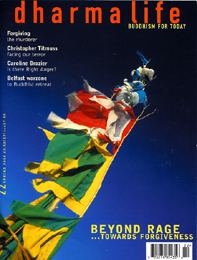Psychoanalysis and Buddhism
An Unfolding Dialogue
Jeremy D Safran
Wisdom 2003
$19.95/£15.95 p/b
'We live and practise in a psychoanalytic universe in which Buddhist teachers are in therapy, psychoanalysts meditate, and spiritual seekers simultaneously pursue contemplative paths and analysis.' Thus Jeffrey Rubin comments in his essay, the final chapter of Psychoanalysis and Buddhism. Psychoanalysis is now a century old. It has been highly influential in shaping western understanding of mental suffering and how to alleviate it. As Buddhism, with its similar concern with the nature of suffering, has become more popular in the West it is not surprising that there has been an explosion of interest in the relationship between the two. This latest book consists of nine essays by psychoanalysts who are Dharma practitioners. After each essay is a commentary by a psychoanalyst sympathetic to Buddhism, followed by a response from the initial author.
From early in their acquaintance with Buddhism, psychoanalysts with their emphasis on strengthening the ego seem to have had difficulties with the Buddhist notion of non-self. Some 20 years ago Jack Engler made the comment that 'you have to be somebody before you can be nobody'. The idea was that you need to be a happy, healthy human being before you can go beyond yourself. Psychological integration first and spiritual progress afterwards. However, psycho-spiritual development is not usually so linear.
Engler in writing the first essay in this book takes the opportunity to update his thoughts on this whole area. In so doing, he produces a highly stimulating contribution to our understanding of trying to practise the Dharma in the West. Engler discusses how spiritual practice can be used for defensive reasons and suggests that some of these mixed motivations may persist even after one has advanced some way along the spiritual path. For example, disciples may feel special in the presence of their guru, which can mask a sense of unworthiness. Altruism may hide or be mixed up with vanity and sanctimony. The spiritual life is much messier than we might have thought. Deep spiritual realisation may co-exist with a certain degree of clinical psychopathology.
Engler argues that the Buddhist critique is not aimed at the psychologically differentiated self (which psychoanalysis aims to strengthen), but is ontological. The Buddhist analysis is about self-representation and shows that representing yourself as independently existing will lead to suffering. He goes on to give an account of different types of self-experience using both Buddhist and psychoanalytic understanding. This includes unselfconscious experience both ordinary (for example, being absorbed watching a sunset) and non-ordinary (meditative absorption or dhyana), as well as experiences of non-self. The issue of self /non-self recurs a lot in the book, although not always with the same lucidity that Engler demonstrates in this chapter.
In recent decades psychoanalysis has lost its hegemony. It has come under attack from humanistic psychotherapies for being overly reductionist and lacking a spiritual dimension, and has been challenged by other therapies (such as cognitive therapy) for lacking an evidence base for its effectiveness. A common theme in the book is how Buddhism can help to revitalise psychoanalysis. Freud recommended listening to patients with an 'evenly hovering attention'.
Sara Weber gives a lovely description of how meditation can help to cultivate this sort of mental state in which there is a non-impinging holding. Interpretation has been a cornerstone of psychoanalysis and at its worst wielded in a dogmatic fashion. Robert Langan applies the Buddhist ideas of form and emptiness to the process of psychoanalysis. In so doing he recommends treading lightly rather than making heavy-handed interpretations.
A major area in which psychoanalysis may be able to contribute to Buddhism is its understanding of transference and counter-transference. Spiritual traditions may underestimate the power of these phenomena and the stubbornness of character traits. Polly Young-Eisendrath suggests different forms of transference that may occur in both the psychotherapeutic relationship and the teacher-disciple relationship. The containing-transcendent is the positive transference that students bring to the relationship by holding the belief that this teacher will be able to help alleviate their suffering. If the teacher mistakenly identifies with the powers of this transference, destructive consequences may ensue.
Another form of transference is the iconic-projective, brought about by old emotional habits and which is the stuff of psychoanalytic work. Young-Eisendrath suggests that in theory Buddhism should eliminate this personal suffering. However this may not happen, depending on the quality of the student-teacher relationship and the student's involvement and commitment to practice.
Throughout the book there is a sense of genuine dialogue, rather than a more partisan approach to either discipline. Within it are many nuggets both for therapists wishing to understand how the Dharma can enhance their work, and for Buddhists hoping to gain a broader understanding of the complexities and dynamics of spiritual development.
Paramabandhu is a consultant psychiatrist and chairman of the London Buddhist Centre



